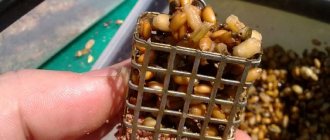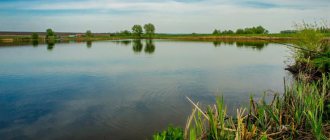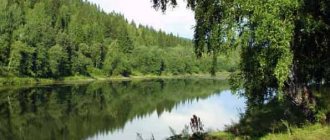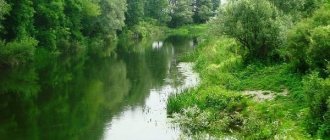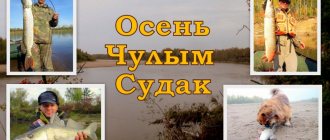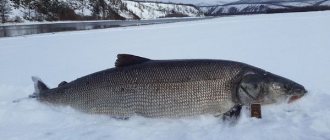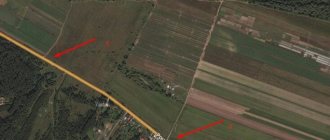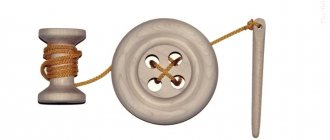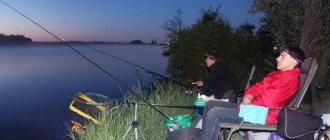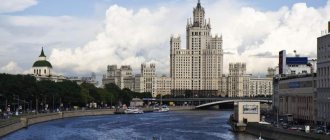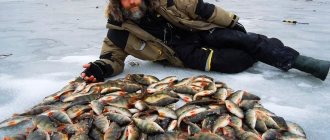Pascal once said a brilliant phrase: “Rivers are roads that themselves move and carry us where we are going.” The Pra River is a “highway” through picturesque places where the Moscow, Ryazan and Vladimir regions come close to each other. Historically, the Klepikovsky district of the 62nd region is called the Ryazan Meshchera. The second word is an ethnonym, hinting at a fairly large Finno-Ugric tribe that lived here.
The smallest (northwestern) part of the reservoir flows through the territory of the Shatursky municipal district of the Moscow region. Almost the entire rest of the channel lies in the Klepikovsky district of the Ryazan region (the mouth is already in Spassky). The Pra River is a left tributary of the Oka. Its slope is insignificant. Food - only snow. Therefore, the current speed is 2-3 kilometers per hour. However, the flow is weak but winding: at some points the parameter can reach 5 kilometers per hour. The average depth is 1.3 meters. In the area of the throat - up to 2 meters. The total length of the channel is 167 kilometers. The catchment area is 5,520 square kilometers (there are several branches). The names of the Meshchera rivers are more of Finnish origin. It is all the more surprising to find among them “pra” - an idiom denoting age seniority in the Slavic (essentially Aryan) language. Apparently, this was the first Meshchera river colonized by the Russians.
Another version nevertheless “subordinates” the hydronym to the language of the indigenous Meshcheryaks, linking it with the concept of “head”. Perhaps here (among the Finno-Ugrians of the Ryazan principality) the Pra River was the most important artery, connecting all their ancestral villages, which later became towns - Chebukino, Kaldevo, Spas, Klepiki, Ekshur and Podgorye. Proulx was best described by Paustovsky - the “singer” of Meshchera. He called it the most “virgin and mysterious”... In Soviet times, canals were built from the most swampy shores, leading to local fields.
Source and mouth of the Pra River
The water body is born from the resources of two lakes – Svyatoy and Dubovoye. Together, these bowls form a curving expanse of water about 15 kilometers long! The river “start” can be seen from the Yegoryevskoye Highway - at the southeastern entrance to the village of Meshchersky Bor. The nearest settlement is the village of Korenets. Swamps approach this unique location from the south (after all, we are talking about lowlands). Islands of reeds form on the water. Moreover, to the west of the named village, the Pra River itself expands to the size of a lake (the maximum spill diameter is 1.66 kilometers). To the north are thickets of river reeds. Forest from the southwest. There are swamps in the south. An agricultural canal running from this point feeds the fields of the village of Ivanovo. It is so beautiful here that visitors usually stop to take photos, and in warm weather, even to swim.
The mouth of the Pra River is located in the Spassky district of the Ryazan region - a few meters southeast of the horseshoe-shaped fragment of the old Oka riverbed. This is the Spatula. This oxbow has long been recognized as one of the most colorful tracts of the Ryazan Meshchera, attracting both fishermen and swimmers. As for the entrance of the described reservoir to the Oka, it is narrow, but at the same time quite deep (2 meters). In the river there is an island (wooded, 145 meters in greatest diameter)... A small creek has formed to the southwest. In late spring, the entire visible area is under water (we are talking about a loan). The nearest settlement is Brykin Bor. From here the river goes most tortuously, making 51 bends in a relatively short section of the route! By the way, on the opposite bank of the Oka there is a higher kilometer-long sandy beach, long favored by tent campers.
Pra River Basin
Beyond the “spill” part, the Pra River again does not exceed 10 meters in width. Goes to the southwest. Among the small fields of the Great Court, it expands to 100 meters, and later absorbs Yalma. A mixed forest appears along the eastern shore, consisting of thickets of alder, birch and aspen. And the spruce forests go in small groups at a short distance. The 12-kilometer Moscow section of the flow has been completed. Further (already in the Klepikovsky district of the Ryazan region) the river tends to the south, southeast, and east, as if “bypassing” the tiny villages of Knyazevo, Gorki and Abrakhovo. It meanders between the other 8 Klepikovsky lakes. Note that passing through Lake Sokorevo, the river basin overflows again and expands at Chebukino to 100 meters. At the same time, he goes a little further into the lowland.
In the vicinity of Averkievo, the reservoir is divided by swamps into 2 channels. In the area of most Klepikovsky lakes, its shores are inaccessible - up to the very south-eastern outskirts of Manshchino (but there are also rare solid areas). “Pravskaya” water acts as wide (up to 100 meters) inter-lake channels. There are a dozen villages in the immediate vicinity. There are already more birch forests here. The last feature is the constant availability of extensions.

In the middle reaches (from the regional center of Spas-Klepiki) the Pra River has a width of 30-40 meters. More and more islands are found in the channel. There are several bridges across it. Closer to the new swamp area you will come to “cordon 273” - a memorable part of the Meshchersky National Park. Here (in the forester’s booth) Konstantin Paustovsky spent a lot of time, writing his best works. Mighty pine trees surround the stream on both sides. Far away (to Deulino) the water flows through a dense coniferous forest. The approaches to the shoreline are convenient (in all seasons except spring). A large network of canals appears on the eastern side. And even further, on the border of the Klepikovsky and Spassky districts, there are steep sandy beaches (the reservoir cuts through the more elevated part of Meshchera for some time).
To the east, the Pra River basin consists of continuous “crossroads” with tributaries. By the way, we indicated only Yalma, but there is also Urazh (on the same side) and a lot of left branches (Belaya, Kad, the river U Kordon Elovka, Vorovka, Sovka and Buzha). Don’t forget about the Klepikovsky lakes, which also share water with the Pra River.
In the Spassky district (lower reaches), the green floodplain of the river, being only 500 meters wide in the upper reaches, expands to 4 kilometers, turning into a dense reed-forested area of the Oksky State Reserve. On one side the shore is also covered with spruce forest. The other side of the riverbed is hidden in low-growing willow, aspen, alder, and dense meadow grass. The banks are swampy all the way to Brykin Bor. Further entry into the water is ideal right up to the mouth. The bristlecone, white aspen, the thinnest naiad and chilim (water chestnut) are today listed in the Red Book of Russia.
Speaking about fauna, it is worth adding that along its entire length the Pra River is the habitat of a relict inhabitant of the taiga - elk, as well as rare roe deer. The wild boar is an introduced animal. Among the predators there are wolves, foxes, raccoon dogs, hare (hare) and badgers. Today, these regions are increasingly visited by violent brown bears. From fur you can find the muskrat. All birds are meadow, forest and swamp. Lots of cranes. The most characteristic of Meshchera are waders, black grouse, hazel grouse, and kingfishers. The Red Book includes Russian muskrat, black-throated loon, black stork and curlew. There are the eagle owl and the gray shrike, which can only be seen at night when the forest area is suddenly illuminated.
Sights of the Pra River
If you explore the source of the Pra River, at the same time explore the Tikhvin Cathedral. It is on the other side of the Yegoryevskoye Highway (only 300 meters from it). Sergei Yesenin especially appreciated the place. As you know, the poet adored the Ryazan region, personifying it with the “real” Russia. What can we say about the cathedral itself? It was originally founded back in the 1890s. Reconstructed to resemble the original (that is, in pseudo-Russian style). It has five domes with hipped domes.
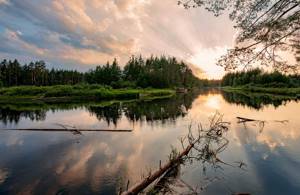
Both recreational and historical holidays on the Pra River are at your service if you reach Spas-Klepikov. In the provincial town there is a museum of wooden architecture. And two more “business cards” - the Church of the Transfiguration of the Lord and the S. Yesenin Museum (ancient buildings where he was raised and studied). 2 kilometers below Makeevo you will find a fairly wide sandy beach. You can have a picnic and spend the night.
In some meadows between Spas-Klepiki and Deulino, lilies of the valley actively bloom in May.
The Trubins’ creative workshop operates in Deulino itself. On an area of 70 acres you will be surrounded by the wonders of Russian architecture and more. Everything that viewers see is the fruits of many years of work by the named family of carvers and home-grown architects. You will photograph their realized fantasies, embodied thoughts, examples of rare talent. Unforgettable works include stucco, forging, mosaics, and painting. Creators receive different orders. Some of the latter are the altar and the ritual staff. Everyone who comes here clicks at least a gigabyte worth of photo frames. Such a place...
The lower reaches and mouth of the Pra River are already the northern part of the Oka State Nature Reserve. The “historical” village of Brykin Bor will tell you everything about the local landscape. After all, there is a specialized Museum of Nature of the Oka State Reserve (it presents stuffed animals against the backdrop of biodioramas, maps, geological artifacts). According to his guides, interesting points for excursions include the habitats of the black stork in swamps and small lakes (the stork is the symbol of this GBZ). By the way, near Brykin Bor the Pra River is in the zone of action of a vivid legend. Here, they say, Ataman Brykin buried his treasures (that’s why the village was called that). What is this character famous for? The leader of the ushkuiniks (river robbers) chose the slightly elevated right bank of the Pra for raids. State troops caught the criminal.
Tourist sites on the Pra River in this sector are also memorable - with large beaches. They are sandy, with a gentle entry into the water. There are almost no other ones like this, so don’t get lost.
River Pra
Possessing unique natural data, due to the prevailing climatic and landscape conditions, the Meshchera lakes play a huge role as natural spawning and feeding reservoirs, fulfilling the most important mission of reproduction and maintaining a stable population of many species of fish.
The main object of spinning fishing on the Pra River is pike. Its migration to the upper reaches of rivers for spawning begins with the appearance of the first thawed patches. Pike moves up the river almost around the clock with brief respites during daylight hours, in the evening and at night - more actively, in the morning and during the day - more slowly. The fish moves forward, choosing areas in the riverbed with the least water resistance, coastal areas along steep banks, where a reverse current most often forms, helping tired fish. For the middle zone, the date of ice melting on rivers falls on April 10–14. In recent years, the timing has shifted somewhat and, as a rule, by the end of the first ten days of April the Pra is already cleared of ice. By this time, the pike not only passes the entire riverbed of the Pra, but also reaches its usual spawning grounds. And if the water temperature corresponds to the beginning of spawning and the coastal zone is opened in the lakes, then pike, in favorable weather, can spawn within 4-6 days. The beginning of the bite depends on the level of the spring flood. The lower it is, the earlier the reverse migration begins, the earlier the fry leaves the coastal vegetation, attracting a predator. If we take into account the established opinion about the period of the painful state of pike, then in any case, from the first days of May, fishing for predators begins. But the period of obvious pike activity begins a little later, around May 9. The ide migrates upward after the pike, sometimes their migrations merge, and the ide begins to spawn immediately after the pike. Although the ide continues to feed during the spawning period, we, I hope, will consider this time sacred and will not take advantage of the weakness of the fish, which is losing its natural caution. The first bites of ide on a spinner begin as it moves away from the spawning grounds. Large ide is caught mainly on the riverbed itself, and roach can stay along the shoreline among rising vegetation, where it is caught with small rotating spoons.
Flood
After the river is cleared of ice, the water level remains virtually unchanged for 4–5 days. Then the flood waters begin to rise, and the peak of the spill most often falls between April 30 and May 2. By this time, the river waters, which become cloudy during the period of ice drift, are already quite transparent. It should be noted that some turbidity of the water has little effect on the biting activity, it’s just that in this case there are more misses and derailments of the predator, focusing on the vibrations of the baits with the lateral line. By the beginning of May, the water warms up to +14 °C, which is quite enough for the fry to emerge and the spring bite to begin. All of the listed characteristics, terms and parameters are tied to the Pra river bed between the main lakes of the water system. On closed reservoirs, ice can remain until the end of April, and even until the first days of May. Therefore, the timing of spawning and biting there, accordingly, is shifted. The best places for spring fishing are sections of the Pra River between the main lakes of the vast water system. They are not spawning grounds, and sport fishing on them is permitted subject to compliance with fishing rules and catch standards.
Pra
The Pra River originates from Lake Svyatogo, 3 kilometers from the village of Korenets, Moscow region.
A fairly wide channel, which is the main channel of the Pra, on a kilometer stretch before it flows into Lake Imles, is an excellent place for spring spinning fishing. It should be noted that in the spring the objects of fishing are not only pike, but also ide, which is already actively feeding, not missing properly equipped baits, as well as perch, which has completed its spawning after the ide. The river section of the Pry's source is promising for spinning fishing in the spring for many reasons: - here spawned pike migrate to summer camps; — there is a vast space that allows accommodation for a large number of fishermen; - alternating depths, shallows, channels of the lower reaches of the river in this area, spaces of aquatic vegetation with attractive “windows”, the impressive water area of the lakes Svyatoe and Imles themselves; — banks quite suitable for parking (if the spring flood level does not exceed the usual levels); — the last three kilometers to the fishing spot lie in the forest zone. The road is dirt, depending on the flood and rain there may be numerous puddles. But the road is passable for almost any vehicle; — the Korenets base is also located here, where you can stay if outdoor recreation seems extreme for some reason. What is fundamental for successful fishing during spring spinning fishing in the group of crowded Meshchera lakes? Due to the abundance of flood waters and, naturally, due to the not so dense concentration of pike, the most promising and interesting places for fishing are areas of the Pra in the area where the river crosses bridges, where the narrowing channel, the bridges themselves and the holes present here delay the migrating pike, collecting in quantities sufficient for successful fishing. Let's take a closer look at these places. 1. The section of the right branch of the Pra at the exit from Lake Sokorevo near the village of Dunino is crossed by a wooden bridge, on which there are convenient parking spots in the picturesque forest of the left bank. Here, a pike passing from above lingers for a long time in a hole with depths of up to three meters below the bridge. Then the Pra goes through a wide floodplain until it joins the channel of the left branch. The coastal floodplain is rich in vegetation, where there are a lot of fry in the warming water, which, as a rule, come out onto the river bed in windy weather. Ide is also a frequent guest in fishermen’s catches, and it can be bitten not only by rotating spoons, but also by fairly large spoons. This is the first echelon of large Oka ide rolling down after spawning. There is much less perch in the catches, because it has not yet left the floods that attract it, and active fishing for it will begin only in June. You can approach the bridge near the village of Dunino from the Ryazan highway along an asphalt highway. Only the last 500-meter section runs along a sandy road.
2. The Pry section after Lake Ivanovskoe near the village of Podlipki, similar to the previous section, also has good parking on the left bank. Directions from the bypass highway to Ryazan through the village of Kaldevo. From Kaldevo to the bridge there is a country road, which in spring is quite difficult, but there is a detour through the village of Terebovo, marked with a “turn right” sign near the village of Levino. In this fishing area below the bridge there is also a hole, but fishing is more promising when casting gear up the river between old ice cutters. Ice cutters have alluvial islands. The bulk of the pike concentrates on the approaches to the bridge. Fishing from bridge decks is convenient and not tiring, so many anglers often gather here, especially on weekends. The attached map shows both branches of the Pra and bridges crossing the river beds in the area of the villages of Dunino and Podlipki. The road between the bridges is practically impassable during periods of medium and high floods.
3. The section of the Pra River below lakes Shagara and Velikoye, crossed by a reinforced concrete bridge on the Spas-Klepiki-Moscow highway near the village of Tyurvishchi. Just above the bridge are the remains of the embankment dam of the old road, where the river was crossed by a wooden bridge, now dismantled, leaving behind many stumps and piles that are clearly visible when the water recedes. Between the old and new bridges there is quite a decent hole of up to 4 m. The bulk of the pike lingers in front of the piles of the old bridge or settles in the hole. Some mass of passing pike goes down behind the new bridge and gathers on the gradually narrowing bed at the confluence of the river into Lake Ivanovskoye (the place is called Kolcha). When fishing in the pit between the bridges, not only spoons are used, but also jig baits. The depth and relative absence of hooks allow you to make completely complete wiring. The river section below the concrete bridge is shallower and holds more small pike and perch.
4. The section of the Pra River before it flows into Lake Ivanovskoye (Kolcha). At this place, the Pra makes a smooth turn, forming a hole up to 4 m, the main depths of which are closer to the right bank, then through one main and two narrow secondary channels the river flows into Lake Ivanovskoye. The right bank is a swampy floodplain, the left bank is sandy and high - a zone of pine forest, where with the beginning of the summer fishing season a whole tent camp grows for lovers of outdoor recreation. You can drive to Kolcha from Tyurvishchi towards Spas-Klepikov, turning after a kilometer onto a dirt road going to the right in the forest. The place is convenient for shore fishing. In the pit, silicone baits and spinners of all types are used, selected depending on weather conditions and the degree of bite. The listed sections of the Pra River are not the only ones where you can successfully catch pike, but they have proven themselves in the best way and are popular with many local fishermen and guests of Meshchera. You can catch pike everywhere, but these will be more likely to be isolated bites, but in the listed places the probability of a good bite is very high. Although sometimes the result itself is not so important as what excites with joy is the long-awaited time of open water and elegant gear in hands that are yearning for their favorite pastime.
This is interesting
It is prohibited to fish on lakes included in the register of spawning grounds, especially from a boat.
In April, the regional inspectorate provides information through the press, designating lakes declared as spawning grounds. Spinning rods equipped for bottom fishing for ide should have no more than two hooks. With a friendly early spring and a rapid rise of flood waters, the ice on the lakes begins to move and rise, tearing off last year's vegetation and carrying it down. Unfortunately, in recent years the ice has begun to melt on the lakes, and ice flow on the river has practically stopped. Hence the process of overgrowing of lakes with previously unusual vegetation, the accumulation and growth of a layer of sapropel and, as a result, an increase in the frequency of death phenomena. Silicone baits with weight heads of about 10 g give very good results with a sluggish bite on spinners. Colors: green, lemon, burgundy. When choosing colors, you need to focus on the degree of illumination and transparency of the water. The main roads in Meshchera are paved, and those sections of roads that are located in forest areas are passable. Movement can only be hampered by very high water levels or prolonged rains. Although the soil in Meshchera is mostly sandy. On weekends, especially during the period of active biting, there are many fishermen in the indicated sections of the river, but, as a rule, there is enough space for everyone, and the ethics of fishing relations are respected. A massive emergence of mosquitoes in Meshchera occurs approximately after the first ten days of May, if the weather is warm. The number of mosquitoes also depends on the level of rising water entering the swamps and oxbow lakes. The midge appears two weeks later, when stable warmth has established.
The material was published in the May 2014 issue
Tourism and recreation on the Pra River

Tourist holidays on the Pra River have a number of features. Its very upper reaches lie in a space of developed transport infrastructure (Egoryevskoye Highway, asphalt roads between the Klepikovsky lakes, the intraregional highway Ryazan - Spas-Klepiki). The source of the Pra River is the location of the comfortable park-hotel "Mikulin Island", several ponds stocked with fish, as well as the already indicated extension of the channel (behind the Tikhvin Cathedral). Therefore, if you are a “mattress person”, welcome to the local recreation centers. Fishing places are already equipped. Equipment is available for rent. Further on there are many settlements with shops, pharmacies, and bus stops. There is also a hospital. The river constantly “jumps” into the lakes, often expanding itself. There is no dense forest... Speaking of the upper reaches, travelers most remember Velikodvorye (a sandy stretch at the confluence with the Yalma River), Chebukino, Kaldevo (small islands of mixed forest), Lake Martynovo hidden in the floodplain forest, and a mini-beach near Polushkino.
Holidays on the Pra River in its middle reaches are connected with the regional center of Ryazan Meshchera - the village of Spas-Klepiki. Here the river is most navigable. Rafting on the Pra River has the least amount of difficulty (only the numerous pedestrian bridges make you strain). Beyond the far outskirts of the village there begins a coniferous forest with a large amount of dry wood. Here you can light an open fire for 9 months a year, fish with a rod for 12 months, and in some places hunt. Even a classic pine forest begins from “cordon 273”. Here you can stop every 500 meters. There are multiple “gaps” in the coastal ravines. One of them leads to the open-air museum of wooden sculpture. But in this same corner there are the most driftwood. Be careful! People ride here on an “iron horse” along the serviceable internal Laskovskoye-Deulino highway.
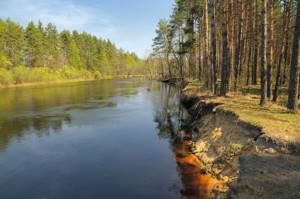
Parking lots on the Pra River can also be arranged in its lower reaches. But only before the land of the Okskaya PA begins. Sailing literally 2 kilometers down from Deulino, there is a chance to find comfortable coins with a lot of brushwood (there is a deciduous forest here). Running out of food? You can always return to the general store of the named settlement. Near Deulino and Old Kudom (and below - all the way to Maly Svyatogo Lake) the shores are not protected. However, in summer you cannot light an open fire here. The ban applies even to thickets free for fishing and tourism. Fire inspectors will come to see the smoke. Use folding grills. If you are “on wheels”, follow the road Ryazan - Spas-Klepiki to Deulino, and we described above how to turn later. Along the way is Solotchinsky Park, and from Laskovsky there will be lakes with marshy shores. There is no access to them. For safety's sake, follow all the way to Deulin without leaving the road.
On the territory of the Oksky GBZ (administratively subordinate to the Spassky district) you need to be more careful. The left bank here is reserved. “Landing”—putting up tents and fishing—is simply not possible. Relaxation on the Pra River is only available on the opposite side - in front of the canals. The swamps will begin only after 10 kilometers of rafting from the sign. And on this 10-kilometer stretch there is a dense mixed forest and a lot of firewood. You can get here by car by heading first to Novy Kistrus (from Spassk-Ryazansky), and then to Brykin Bor (already along a secondary road). Next is the primer.
Kayaking on the Pra River is a real pleasure. The route is not extreme at all, there are only a couple of inconvenient places. In a homemade “sculpture museum” (craftsmen carved mysterious figures from the bases of dead trees), kayakers attach signs with the name of their city and the date of arrival to the trunks of tall pine trees. During high water, trunks and branches “occupy” the banks of the flooded river. You need to know how to maneuver. There are, of course, more streams in May. You have to be able not to get lost in them.
Rafting on the Pra River (on catamarans, kayaks and rafts) also takes an organized form. Specialized tour operators are recruiting groups to travel the Spas-Klepiki (Pervushkino) - Deulino route, the features of which have just been described. A chartered bus delivers water extreme sports enthusiasts from Ryazan. He picks them up in Deulino. Such rafting on the Pra River takes 2.5 days. You will cover a total of 70 kilometers. Experienced watermen usually walk the entire river. But such a journey will take at least a week, and in the lower reaches of the fire, rangers from the Oka State Protection Zone will constantly gather to watch the smoke (they will need to make sure that the fire is burning in the grill). Under no circumstances should kayakers be picked up from here by car. This is a water protection zone.
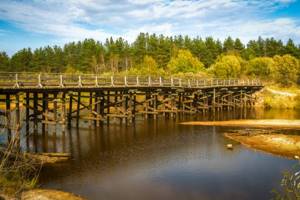
Fishing on the Pra River
Fishing on the Pra River is best during the warm season. The optimal months for forays into the pond are June, July, August and September. At this time, you can comfortably sit on the shore, pitch a tent, the fish behaves actively and readily responds to the offered bait.
The best ways to fish on the Pra River are with a spinning rod and a float rod. The second option is the most acceptable, suitable for almost all underwater inhabitants inhabiting this body of water. It is optimal to use a classic swing with blind equipment. On uneven terrain, it is advisable to install a sliding installation.
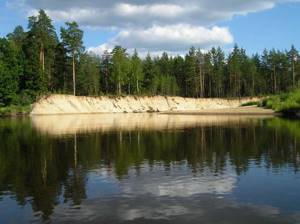
On the Pra River you can fish both from a boat and from the shore
In addition to the fly rod, you can successfully use:
- plug rod;
- long-distance casting tackle or match;
- Bolognese fishing rod.
Baits include worms, maggots, caddis larvae, grasshoppers, flies, and other insects that live along the banks of the river. Among the attachments you can use canned corn, dough, bread crumb.
Fishing on the Pra River with a light spinning rod allows you to catch small-medium pike, perch of various sizes, chub, asp and ide, and sometimes dace. The best lures are miniature crankbaits, minnows, topwaters, small spinners and micro-spinners.

On the banks of the Pra River you can set up a camp and stay overnight
In addition, you can use microjig. This method is especially good for fishing perch. It allows you to carefully fish every nook and cranny of the area, examining the terrain and discovering the predator’s camp. It works all year round, regardless of the mood of the striped robber.
It is best to fish with a micro jig on Pre in the summer. Among the baits, preference should be given to small slugs and twisters made of edible silicone. The mounting is hinged on light eared weights, the “rubber” is mounted on small single hooks or offset hooks.
